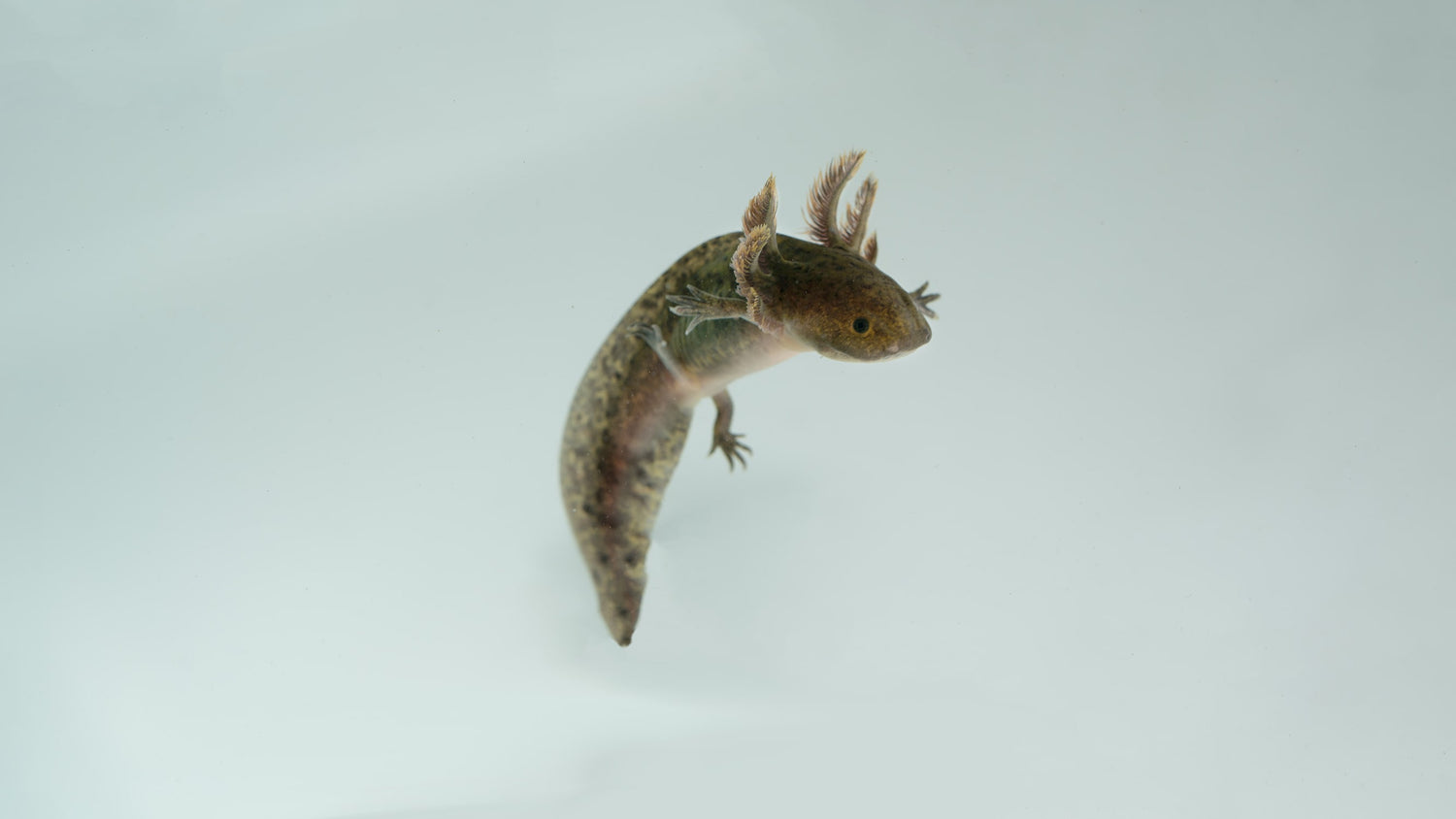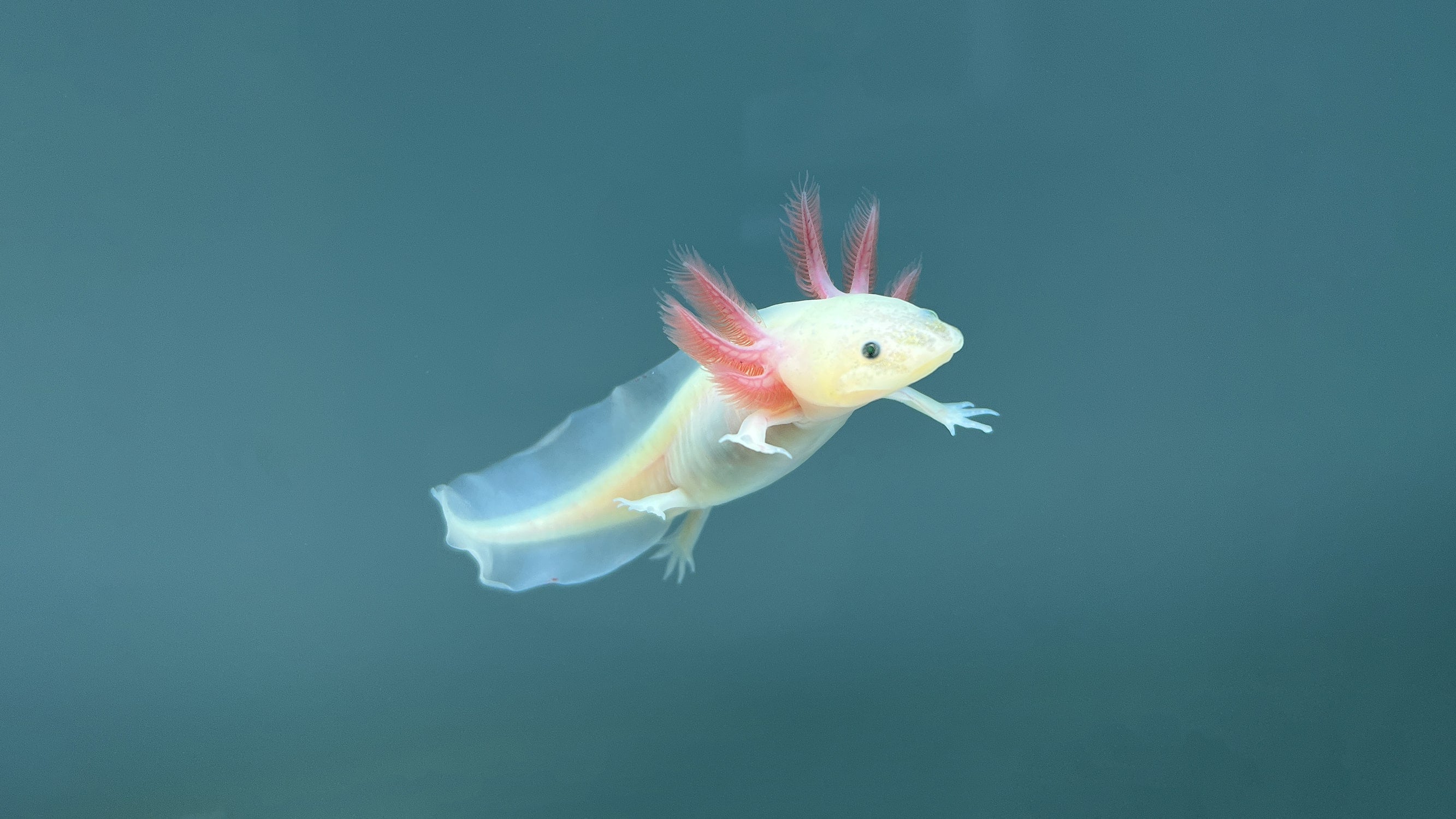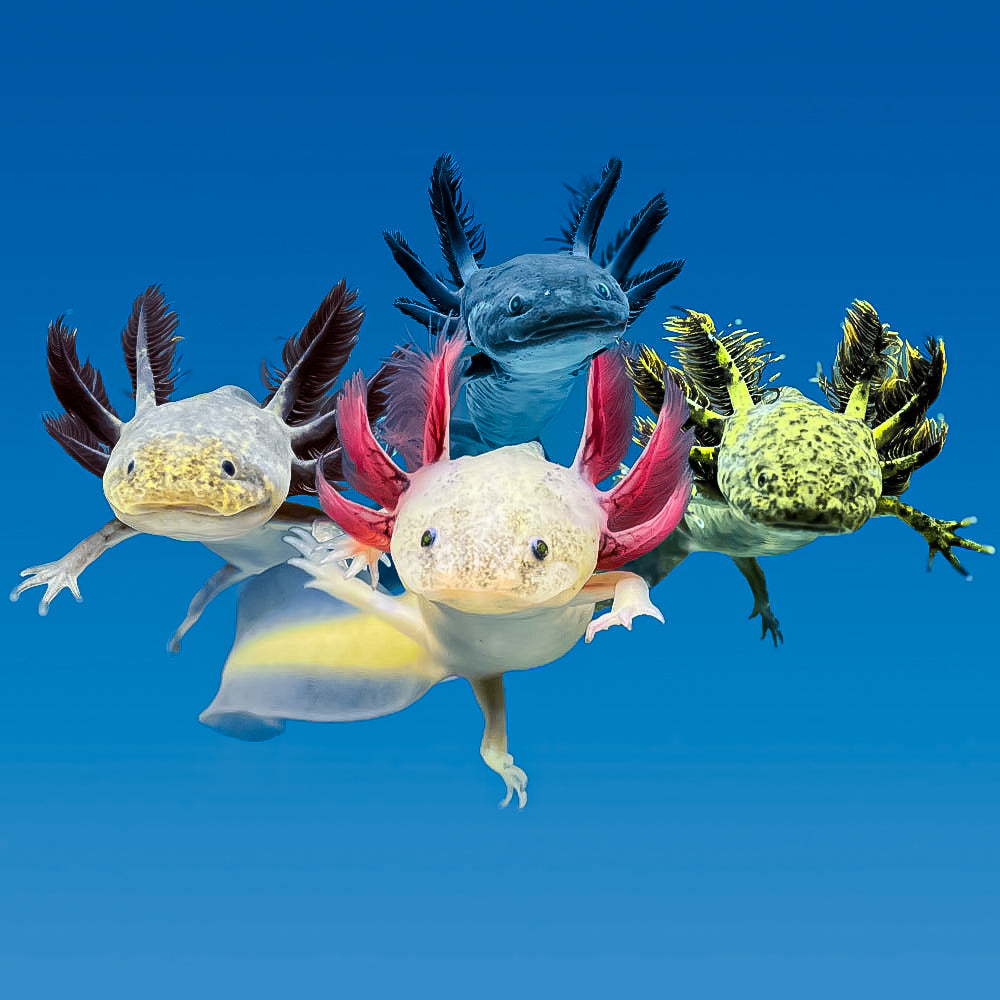What is a morph?
A morph is not a true scientific identifier, but it is the common term used by axolotl breeders and enthusiasts all around the world to describe a specific axolotl color, or phenotype. Axolotl colors are determined by their genetics, and the morph name is usually chosen by breeders in a way to help people quickly understand what specific genes are being expressed by an axolotl. Each and every axolotl is a unique individual, but some possess colorations that are more rare than others! In this article we will talk about the most rare axolotl morphs in the world and what makes them so unique and difficult to find!
Melanoid Axanthic Copper Axolotl

Melanoid axanthic copper axolotls, or MACs, are gorgeous axolotls! They are a beautiful lavender-hued brown whose gills can become a deep magenta when “fired up”. MACs are one of the rarest axolotls that can be selectively bred because they express three recessive traits simultaneously. They are melanoid axolotls, which means they completely lack all light reflecting skin pigmentation, called iridophores, and have a surplus of dark skin pigmentation! They are also axanthic, so they lack all yellow pigmentation, called xanthophores! And they are also copper, so the skin pigment that should be black, eulmelanin, is instead reddish brown, pheomelanin, resulting in the axolotl you see above! It takes careful tracking and determination of genetics, bloodlines, and selective breeding to produce a Melanoid Axanthic Copper axolotl! The difficulty in breeding the correct genes, as well as the fact that melanoid axolotls have weaker immune systems due to a lack of pteridines, make these axolotls one of the rarest morphs in the world!

Hypomelanistic Axolotls
This entry is different from the others as it actually encompasses several morphs of axolotls, but currently they are all similarly rare! Hypomelanistic axolotls are extremely unique because they are the newest color of axolotl to be discovered! Hypomelanism is a brand new mutation that means that all the dark pigmentation of an axolotl is produced at a lesser rate than it would normally! What’s more, the hypomelanistic gene can occur in various combinations with other heritable genes! So far, the known variations of Hypomelanistic Axolotls are:
Hypomelanistic
Hypomelanistic axolotls only express the hypomelanistic gene and no other! They normally would appear as a normal wild type axolotl, but because of the recessive hypomelanistic gene,they haven’t developed as much melanin in their skin. The other color pigments, xanthophores and iridophores, as a result of not being covered by black and brown skin pigment, now appear much more pronounced.

So, this axolotl morph is exceptionally yellow and shiny with a scattering of black spots along its body! These axolotls, as well as Hypomelanistic Copper axolotls, can easily be confused with a Non-Albino Golden axolotl for those who don’t know what to look for, but they are something else entirely.

Hypomelanistic Copper
Not to be confused with a normal Hypomelanistic axolotl, the Hypomelanistic Copper is also an incredibly vibrant yellow and shiny color of axolotl with a surplus of iridophores along its gill stalks, caudal fin, and legs. It also has a scattering of reddish brown spots along its entire body instead of black like the regular hypomelanistic axolotl! These axolotls look like they could be non-albino golden axolotls but are actually coppers (denoted by the red pupils) with a reduced development of pheomelanin!

Hypomelanistic Melanoid

Hypomelanistic Melanoid axolotls are one of our personal favorite morphs! Because of the reduced black pigmentation in their skin, the xanthophores beneath their skin become more evident, which causes the axolotl to take on a range of hues from white, to gray, or to a pale lavender color! Some hypomelanistic melanoids will even have very high concentrations of xanthophores on their faces and along their backs! They also tend to develop darker spots of melanophores along their head and back as they grow!

Hypomelanistic Copper Melanoid

These axolotls for the longest time were thought by breeders to just be light copper melanoids, but they are actually a hypomelanistic axolotl! They produce way less pheomelanin pigment than a copper melanoid axolotl normally would and, as a result, tend to have a beautifully pale coloring that can easily be mistaken for a leucistic or albino axolotl! Some hypomelanistic copper melanoid axolotls also display beautiful xanthophores along their heads and bodies and also develop darker spots of pheomelanin along their dorsal crest.

Piebald Axolotls
Piebald axolotls are dirty leucistic axolotls which have melanophores (dark skin pigmentation) in much higher concentrations than any other leucistic axolotl. Usually this dark pigmentation is concentrated on the face and dorsal ridge of an axolotl, though some piebalds are known to have large dark spots all over their body!

(photo credit: Axolotl City)
Piebalds are not a distinct morph unto themselves from regular dirty leucistic axolotls, however. A piebald axolotl bred with another piebald will not be a guarantee for more piebald offspring! The fact that the specific arrangement of chromatophores required to make a piebald axolotl isn’t something you can selectively breed for is why piebald axolotls are so rare!
Mosaic Axolotls

(photo credits: The MerriMan’s Axolotls, all Mosaic Axolotls)
Mosaics are a very special kind of axolotl, and one of the rarest kinds in the entire world to find, because they only happen due to a mutation occurring during the development of the axolotl as a zygote. This mutation causes the axolotl to develop with two or more genetically distinct cell lines, each with different sets of instructions for how the axolotl should develop. Sometimes, if these cell lines contain instructions for different skin color variations, you get very beautifully mottled axolotls, or axolotls that are two different colors split right down the middle or multiple patches of different colors all over the body! These are easily identified as mosaics! What is extremely amazing about mosaic axolotls is no two are ever alike. Each is a completely unique individual with unique color combinations and patterning!
However, not all mosaic axolotls are so easily identifiable. Some mosaic axolotls do not have two different colors in their cellular instructions and may appear like a regular axolotl in terms of its coloration, but have different gill lengths on each side of their head, leg lengths, or a different belly shape on either side of the body. These mosaic axolotls oftentimes are never identified as mosaic by their owners!
It is important to note that most mosaic axolotls breed normally and do not harbor any bad genes, despite themselves having some physical anomalies! It is impossible to selectively breed for a mosaic and, on top of that, mosaicism is a very rare genetic mutation. Two mosaic axolotls are not more likely to produce another mosaic axolotl than any other random pairing of axolotls. This makes mosaic axolotls one of, if not the most, rare “morph” of axolotl in the world! There is only one other axolotl morph that is just as rare which we will talk about below!
Non-Albino Golden Axolotl
You may not have even heard of this morph before, that’s just how rare they are! Exceptionally beautiful, non-albino golden axolotls (called NAGs) have quite a few distinct characteristics. First and foremost of these characteristics is that they are not albino animals, and so they have melanophores in their eyes, giving them black pupils! They also have lots of melanophores grouped on the ends of their tails, along the edges of their caudal fin, and sometimes sprinkled along their face. Their second most defining characteristic are tons of iridophores mainly concentrated on their legs, gill stalks, and in their eyes! Third, they have an abundance of xanthophores all over their body, giving them that unmistakable golden hue.

(photo credit: Hog and Lotl axolotl breeder)
Unfortunately, and unlike mosaicism, the mutation that produces these types of axolotls is not concretely known, though it is suspected by some to be a chromosomal aberration. As a result, non-albino golden axolotls often do not grow into adulthood and, those that do, appear to be female. Non-albino golden axolotls are also always infertile. The difficulty in producing a NAG, along with the high chance of death as it develops, makes Non-Albino Goldens, quite possibly, even more rare to find than a mosaic axolotl!
Conclusion
There are over 30 different morphs of axolotls in the world, but these are some of the rarest! Some of these axolotls you can find with some regularity from specific breeders, but others, like the mosaic and non-albino golden axolotl, are almost impossible to find and can cost thousands of dollars if you are ever able to find them! As always, we hope you enjoyed learning more about axolotls and, if you are interested in getting an axolotl as a pet, we highly recommend checking out our Bulletproof Care Guide for new owners and our Aquarium Cycling Guide!





Leave a comment
This site is protected by hCaptcha and the hCaptcha Privacy Policy and Terms of Service apply.